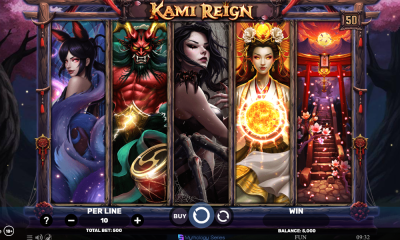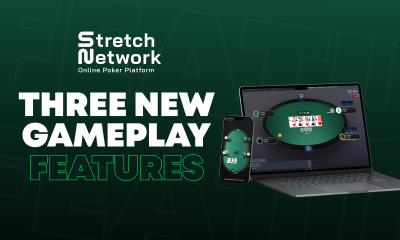Interviews
Mobile-first gaming round table with experts from Habanero, Evoplay, OneTouch and ESA Gaming

In recent years, mobile-first gaming has rapidly risen as smartphone companies continuously enhance their products, making it easier for players to access games whilst on the go. This technological development has brought forward an industry shift, that has seen iGaming companies redirect their focus towards mobile-first content.
With more and more companies embracing the increase in mobile gaming, we explored the success of this new generation offering and what the future holds.
According to you, what brought forward the increase in mobile-first gaming?
Arcangelo Lonoce – Head of Business Development at Habanero:
The watershed moment came a number of years ago when smartphones finally managed to deliver a properly premium gaming experience. Indeed, phones have improved exponentially to the point where you could argue that mobile technology is as good as if not better than desktop.
This has been made possible by the improvements in ‘light betting’, by which I mean data, allowing players to enjoy parallel matches etc. When you can reach that point, laptop gaming becomes obsolete as you can flick through just as seamlessly as on desktop. Just of course like the wider world, when it comes to relaxing on the couch, mobile will always be your primary channel over a laptop – whether that’s shopping, gaming or Instagram.
Of course, with HTML5 becoming ubiquitous and flash disappearing has accelerated the mobile-gaming trend. You can look at emerging markets or countries that never went through the ‘laptop era’, as given the leap in tech developments in the last decade, it means that smartphones are simply more affordable and accessible to players than MacBooks ever will be. Latin America is a great example of this.
Vladimir Malakchi, CCO at Evoplay:
The accelerated growth and penetration of global smartphone usage across every corner of the world is the key driver behind the impressive rise we have seen in smartphone gaming. Data from 2021 reveals that over 6 billion people use mobile phones worldwide, and this number continues to grow, with the 5G standard being one of the catalysts. Emerging markets are catching up fast too – with the majority of regions now greatly investing in the development of mobile technology.
In addition to this, according to our research, three-quarters of gamblers prefer to play on mobile, doing so every 4.2 days on average. Other sources show that in 2020, 50% of the online gambling revenue came from mobile, which isn’t surprising as 75% of traffic belongs to mobile. The numbers clearly don’t lie, and the high demand for mobile gaming is a call to action for suppliers to accept this trend.
Thomas Smallwood, Head of Marketing at ESA Gaming, comments:
A mix of technology and convenience is the short answer. Mobiles now provide a simpler and faster way for players to enjoy their favourite games. It’s fair to say that the trend towards mobile has also probably been accelerated during the pandemic as the move from retail to online has quickened.
Madis Raus – Head of Product at OneTouch:
Obviously, the widespread use of smartphones and availability internet has had a positive effect on mobile-first gaming. These days people use mobile devices to perform certain tasks, their far easier to use and more accessible than laptops and desktops. Additionally, mobile devices allow people to do things whenever and wherever they want, whether they’re commuting or simply passing time.
By making the mobile-gaming experience seamless and engaging at the same time, players will continue using mobile devices for entertainment. This is something which will naturally increase over time, as mobile devices continue advancing and being capable to perform at higher standards.
Are there any verticals that perform better on smartphones? And how can developers improve those verticals that don’t work as efficiently?
Arcangelo Lonoce:
As an expert on slots and table games – I would say table games are inherently easier to develop and render when performing on smartphones compared to slots, but if we look at numbers, slots are dominant, with a market share of around 85% or so, which shows that the player demand this vertical more than any other.
However, looking at table games, there’s a lot to be said about performance. They have excellent stable rates of acquisition and retention – so there is less motivation to tweak a formula that is clearly working. They also have higher average bets, greater lifetime value and from a mathematical and user interface viewpoint, I would certainly rank them up there as one of the best performers.
Given market demand though, we can assume slots will always retain the lion’s share. So how does one improve the vertical? Stories, subject matter and narrative are key, as is the UI, although we mustn’t forget, it all starts with the maths – you need to get that right first, and then you can start talking other improvements.
Vladimir Malakchi:
Actually, all verticals and mechanics perform well on smartphones. However, while creating a product for hand-held devices, there are key principles to follow: easy-to-understand UX, simplicity of a game, uncomplicated graphics, and adaptation to vertical view.
One thing is for sure – it makes no sense for suppliers to choose a specific type of game to develop for smartphones. The fundamental point is to accept that the mobile-first approach is a basic demand for players.
Thomas Smallwood:
I think sports betting is a natural vertical for mobile. With the ability to play high-quality live streams on mobile devices, in-play betting is no longer just for retail or desktop and the fact that bets can be placed anytime, anywhere is a major factor.
The limit in phone storage also means that casino can be trickier on mobile, especially in apps where users often need to download the games they want to play exactly because of this limitation.
These are two factors behind ESA Gaming’s development of ultra-lightweight games for sportsbooks. The EasySwipe suite of games is accessed through a widget we have designed and developed which enables players to seamlessly move between games and sports bets rather than being re-directed to another part of the site or a cumbersome casino page. The sports betting experience is unhindered and conversion to casino games happens at lower cost.
Madis Raus:
Mobile device usage differs slightly from desktop usage, this means that mobile users have different expectations. Since people use mobiles to pass time or when they’re in between things, the attention span of the mobile user is often shorter, these are things to consider when providing content to them.
In my opinion it’s the matter of the speed of games rather than specific verticals, fast games tend to perform better, as the player doesn’t need to wait too long, which is a bonus especially when they’re looking to kill some time.
To improve further, developers need to consider the peculiarities of mobile device usage and think about ways of implementing content that doesn’t depend on usage patterns, making the products more appealing and engaging to players.
What are the difficulties of adopting games to function on smartphones?
Arcangelo Lonoce:
Habanero as a company operates with a mobile-first approach, therefore, we don’t find any real challenge when it comes to rendering games on mobile since our products are designed with smartphones in mind. After all, we disposed of Flash in 2015 and since then we have always developed our games using HTML5.
Vladimir Malakchi:
Adapting a visual component to all models of smartphones, including early versions, isn’t an easy task but is possible thanks to cutting-edge technologies. They allow us to create visually stunning products compatible with most smartphones. The optimisation of UX, UI, resolution and graphics for all platforms is the main priority, as we want to ensure that our players get high-quality content on any device.
Another challenge, which we have also overcome, is the amount of data used by games. Our proprietary game engine Spinential, developed in-house has been a real gamechanger for us, accelerating the loading speed and optimising the storage capacity. This solution has been designed with a purely mobile-first approach in mind, and we’ve really reaped the benefits.
Thomas Smallwood:
The obvious thing is the greatly reduced screen space and the practicality of a hand-held device. Because of this, we have chosen to develop ‘mobile-first games’ and move away from adapting desktop content. This means every aspect of the game is thought out with the mobile user in mind, ideally with the ability to do everything just with a thumb. Of course, the challenge is to make everything on the screen accessible, so it is a constant evolution as the user demands more features.
Madis Raus:
Different game types have different elements, for slots it may be the screen ratio, for example how to make symbols as big as possible and still keep the popular grids. Alternatively for Live games, you need to consider the screen size, ensuring that the player can see what is happening in the stream and whether the cards shown are in sync with what’s being reported etc.
As mentioned above, when adapting games, it’s important to consider the peculiarities of mobile device usage, developers must think about ways they can make games as fast and seamless as possible but at the same time still engaging on a smaller screen.
How fundamental is it for operators and developers to adopt a mobile-first strategy?
Arcangelo Lonoce:
It’s extremely important, otherwise you’re missing out on 80% of the market! There were some suppliers that were very late to the HTML5 adoption, which made it incredibly frustrating for operators – plenty of which I saw first-hand back when I was at BetVictor during the 2010s. To put things into perspective today, you simply cannot launch a game as without considering a mobile-first approach, since you’re forgoing an absolutely huge amount of revenue.
Moreover, mobile gaming allows people to play remotely, therefore players don’t need to depend on a desktop or laptop to participate in their hobby. With mobiles advancing and 5G becoming the norm, we’re now looking at a whole new world of possibilities to enhance mobile-first even more, the ramifications of which will be huge, especially when it comes to content and loading speeds.
Vladimir Malakchi:
Keeping in mind the number of global smartphone users, prioritising mobile devices when creating gaming products is a must. Moreover, it is expected that in a couple of years, this number will grow to seven billion. Currently, the US, China and India lead the list of countries with the highest rate of mobile penetration. However, as the latest data shows, the potential of emerging markets in regard to mobile usage shouldn’t be underestimated. This is a direct sign for suppliers to throw all efforts on products focused on mobile gamblers. The mobile-first approach isn’t just a trend, it is a philosophy, which is getting more and more supporters. There is no better time to embrace mobile-gaming than now.
Thomas Smallwood:
You could argue it is a percentages game. When desktop provided the higher user count it made sense to develop content for desktop. With the advancements in mobile technology, the increased numbers using mobile and the loyalty associated with apps I think a ‘mobile-first’ strategy is key in the growth of any gaming brand.
Madis Raus:
This is very essential, especially when it comes to companies surviving in this extremely volatile industry. Just by looking at how much traffic is already generated from mobile channels, you can see how strong the area is, and there’s nothing that indicates a potential decrease in mobile device usage.
If companies wish to attract modern players, it is really essential to adopt a mobile-first strategy, as modern players will look for a seamless mobile experience, if it isn’t available on your brand then they will simply look elsewhere.
With smartphones continuing to evolve, what does the future hold for mobile-first gaming?
Arcangelo Lonoce:
I would expect mobile-first gaming to be the only way forward – it’s the old debate on how much entertainment is a part of iGaming. Whilst entertaining is a key aspect, you must also keep the experience flawless. Certain things haven’t worked out, 3D gaming for example, as we’ve learnt that people don’t really gamble to get lost into the symbology of the slot – but rather the thrill of the win, which is the entertainment.
So, in my view, mobile gaming will gain an even larger market share than it has now, it could soon become by far the only way of enjoying this experience. Additionally, with new demographics coming online, the future holds lots of opportunities for interaction of everything from social to multiplayer, shared in any possible way. Cross-sell opportunities are also endless, with push notifications and the like, as players can carry their game anywhere they go – whether that’s being entertained at home, when out and about or during the commute.
Vladimir Malakchi:
I am sure that we will see an industry-wide adaptation of gaming content to mobile platforms in the very near future. Once the value of mobile gambling is fully understood, the industry will immediately aim to transform existing and future products.
I believe the iGaming world will continue to develop in this direction as an exponential pace, focusing on innovative technical solutions, mechanics, features and visuals optimised for various mobile platforms, models and markets. The key is to find the balance between the quality of gaming products and their adaptation to mobile – and getting this right is where developers need to be investing their energy.
Thomas Smallwood:
Smartphones will continue to develop but I would place more focus on the changing user demands. New game types, more regional content as well as promotion and gamification features are already driving us to change the titles we design and develop.
We will soon launch new in-game promotional tools for operators as well as new style of games, including bespoke games.
Madis Raus:
I believe that the introduction of 5G will bring a ton of opportunity to the table, as the introduction of 5G will bring forward a range of improvements to speed and accessibility. This may also give developers a bit more freedom when they think about creating games for mobile phones.
With smartphones being so advanced these days, the size of the game doesn’t matter as much as it once did, the quality is now the utmost important factor when it comes to designing new mobile-games. This is the same with live content, with the technological improvements, it’s now easier to provide good quality streams, so now developers need to focus on other elements that will make their game stand out from the competition.
Powered by WPeMatico
Black Cow Technology
Inside Black Cow’s Decision To Go All In On Multiplayer

Reading Time: 3 minutes
Black Cow Technology Founder and CEO, Max Francis, on why the company has shifted focus from software development to game development, and why he believes multiplayer is the future of online gambling entertainment
Black Cow has just announced its transition into a multiplayer content provider. What made you refocus the business in such a way?
We truly believe that multiplayer is the future of online gambling entertainment, and with our own technology capable of building next-gen multiplayer experiences, we wanted to transition into a content-led business and release some innovative games of our own. Our Multiplayer RGS is especially powerful, allowing operators and suppliers to bring multiplayer gameplay to any game format, even including non-gambling events. Black Cow’s robust, reliable and highly flexible technology is already used by some of the biggest organisations in the industry, including the likes of DraftKings and Light & Wonder. The shift into creating our own multiplayer content enables us to build on our successful Remote Game Server (RGS) and Jackpot Server technology to create first-of-its kind games offering unique player experiences via our Multiplayer RGS platform.
Tell us more about your Multiplayer RGS and its capabilities. What sets it apart from similar solutions in the market?
Our Multiplayer RGS has been several years in the making and is already live with Light & Wonder. Our Multiplayer RGS can be used to create multiplayer experiences across anything from slots and table games to crash, plinko, lottery, live dealer and bingo. Games can be player-cooperative or player versus player. The system’s capabilities are really only limited by the imagination of the people using it, and that’s why we’re so excited to be moving into the realm of game development so that we can push its limits to disrupt online casino lobbies with Black Cow content.
Taking a business in a new direction is a significant undertaking, not without its risks. How have you approached this transition?
It was clear to me that we had the technology to create multiplayer content, but not necessarily the experience to date, and that’s why we’ve been making strategic hires. This year we have promoted Paul Jefferson to the role of Chief Technical Officer and we have welcomed two more big-hitters to the business – Ernie Lafky as Chief Product Officer and Shelley Hannah as Chief Operations Officer. Ernie is taking the lead when it comes to what our games will look like and how we combine key elements like multiplayer, gamification and social interaction. Shelley is managing the operational aspects of our transition to a hosted product-first model. In terms of mitigating the risk, it comes down to the deep rooted confidence we have in our technology and our fantastic team, plus our belief that players are seeking social multiplayer entertainment.
Why do you have such a firm belief that multiplayer content is the future? And to what extent will it dominate online casino game lobbies?
It’s not the future, it’s the now. You just have to look at the experiences offered by other online entertainment options to see that they are becoming increasingly multiplayer and social. From dating to streaming, social media to mobile gaming, consumers want to engage with products and experiences that can be enjoyed with others. But online casino and sports betting sit at odds with this as they have been, and remain, mostly solitary experiences. We have started to see a bit of a shift away from this, first with live casino and then the rise of the crash game format. But this is just the start of what multiplayer online gambling entertainment can look like, and at Black Cow we have the vision, people and technology to really spearhead the multiplayer movement and be a true leader in the space.
As for the degree to which multiplayer content will dominate online casino and sportsbook lobbies, I think it has the potential to be significant but there will always be players that want to engage with more traditional games, products and experiences, so it will be down to each operator as to how they promote multiplayer games. Naturally, this approach will differ from brand to brand based on their specific player-base.
What can we expect from Black Cow now that your transition into a multiplayer game developer is well underway?
Paul, Ernie, Shelley and the team are working hard on our initial product roadmap, including the first run of games that will leave our production line. This is a really exciting moment for me and the whole team, as it will bring our vision to life and set the blueprint for what our multiplayer games will look like moving forward. It goes without saying that our multiplayer games will embody the core values we have built Black Cow on – reliability, flexibility and robustness. This is a big change for Black Cow, and change does bring challenges. But we are all aligned and excited by the new direction. Success is never guaranteed, but we are walking into the next chapter of the Black Cow story confident that it will be our best yet.
The post Inside Black Cow’s Decision To Go All In On Multiplayer appeared first on European Gaming Industry News.
Interviews
Scaling With Purpose: RedCore’s Tech Vision Explained

Reading Time: 7 minutes
At SiGMA Central Europe in Rome, European Gaming Media sat down with Yevhenii Yankovyi, Vice President of Technology and Deputy CTO at RedCore, for a deep look into what truly powers RedCore’s large-scale engineering operations.
RedCore is known for innovating at enterprise level, yet moving with the agility of a fast-growing tech company. In this conversation, Yevhenii breaks down how the organization manages that balance: how engineering teams maintain both speed and reliability, how automation empowers creativity, and why culture must remain a daily practice rather than a one-time achievement.
Can you introduce yourself and RedCore’s approach to engineering at scale?
Sure. My name is Yevhenii, I’m the Vice President of Technology at RedCore and Deputy CTO. RedCore is a large company with many products and projects, so everything we do operates at a significant scale. And when people hear “enterprise-level engineering,” the usual assumption is that scale automatically means slowness: slow decision-making, slow implementation, slow testing, slow time to market.
That’s the mindset we challenge. We don’t believe speed and stability are opposites. In our experience, at this level of complexity, the two actually reinforce each other. When you build the right processes, the right technical foundations, and the right organizational structure, speed becomes a natural result of stability – not something that contradicts it.
We plan for scaling from day one. For us, that’s a fundamental requirement. We build products with the expectation that they will grow, and growth means scale. So we design with that in mind from the very first line of architecture.
But that doesn’t mean disappearing for six or ten months to design the “perfect” system. That’s the common mistake people make when they hear “design for scale.” Our approach is different: we keep the long-term vision in mind, but we move fast, iterate, and make sure the product can evolve without slowing the team down. Stability and speed working together – that’s the engineering culture we build at RedCore.
How does RedCore balance speed and stability in daily engineering?
I will explain this with a simple metaphor: think about a car. Everyone talks about acceleration and top speed, but none of that matters if you can’t take a corner. Speed alone is not the winning formula – you also need control.
That’s exactly how we look at engineering at RedCore. We want to accelerate, make decisions quickly, and develop fast. But we also need the ability to slow down at the right moment, change direction, and stay agile. Balancing speed with stability is the only way to move at scale.
There are many layers to this – it’s a topic I could talk about for days – but in a nutshell:
at a big scale, you must have strong standards, clear policies, and a high level of automation. We rely heavily on automation: infrastructure as code, CI/CD pipelines, automated testing, and all the tools that remove repetitive, routine work from engineers’ daily lives. When the routine disappears, people can focus on what humans actually do best: creativity, problem-solving, and innovation.
However, automation doesn’t build the software for you. It creates a safety net. It catches mistakes, guards quality, and supports engineers when their creativity pushes boundaries. In other words: tools give freedom, and also protect that freedom.
And of course, this includes AI and many other modern tools. We use whatever helps us keep the balance: give people space to think, create, and experiment, while ensuring the system stays stable, predictable, and high-quality.
How does RedCore’s management keep teams aligned yet fast?
First of all, we provide clear goals. As I mentioned earlier, we always design for scale from day zero – but you can only do that if you know exactly what you’re building, for whom, and why. We have a very strong business team that understands the market and what needs to be delivered. The technology team works side by side with them, reinforcing them.
Once the goals are clear, we begin small. If you try to build a huge system from the beginning and get it wrong, you create a nightmare: something no one can support, change, or grow. Complexity grows exponentially, and humans don’t think exponentially; we think linearly. That’s where companies often get lost.
So we avoid that by validating early and validating often. We start with small steps, keep a close eye on every direction we take, and confirm that what we’re building is truly needed by the market. When we see that the direction is right, then we scale – and by that point, the foundation is already in place. It’s like preparing a launchpad so that when the time comes, the team can accelerate immediately.
We build block by block and work in iterations. We take a small team – one, two, maybe three people – and let them experiment for a week. We test the idea fast, get quick feedback, and bring it to the business side: “Do you like it?” If the answer is yes, then we continue, still following all the proper engineering practices before anything goes into production.
This constant loop between business and technology keeps everyone aligned. We give feedback, we receive feedback, and we move together. That’s how we stay both fast and coordinated, always ready to scale when the direction is confirmed.
How does automation empower engineers without slowing them down?
When we talk about automation, we’re really talking about optimization at scale. It doesn’t make sense to over-engineer small things, but at the scale we operate, the cost efficiency and speed gains are enormous. And people often assume that big systems and automation automatically slow everything down. For us, it’s the opposite.
The tools we introduce are not meant to tie engineers’ hands with bureaucracy. We don’t force strict guidelines or heavy processes that kill creativity. Our tools exist to help: to prevent mistakes, to collect feedback quickly, and to give teams the shortest possible path from idea to validation.
Here’s a simple example: we start experimenting with a small feature. We build a tiny prototype to see if the idea works. If it’s promising, the next step is testing, pipelines, deployment – all the things that normally take time. In many companies, engineers would try to do all of this manually because “building the tools will take too long.” But with us, the tools are already there. The infrastructure, the CI/CD, the automation – everything is ready to use. Our engineers are essentially customers of this internal platform that supports fast, safe delivery.
We have many different teams that have different great ideas. If one team tries something new and it works better, great – we learn from it. If another team has a different approach because of product specifics or release schedules, that’s fine too. We give freedom to the teams to work, share their experiences, and then scale.
Of course, there are non-negotiables. When it comes to security and data privacy there is zero tolerance. These are areas where strict rules are absolutely necessary. I always tell the security people: everyone should be a little afraid of you, because these things must be perfect. But outside those critical areas, we don’t impose rules that slow teams down. We experiment, gather feedback, adjust, and keep improving.
We’re constantly researching, experimenting, and customizing our automation depending on the product and the market. But when it comes to system design, we don’t reinvent the wheel. We choose globally recognized tools and industry-validated technologies. So yes, we empower engineers with automation and the right tools, built on a solid, modern foundation.
How does culture work for you – is it an achievement, or part of your routine?
Culture is a critical element in balancing speed and stability. Tools and processes matter, but culture is what truly empowers a team and keeps everything together at scale.
For us, culture starts with giving people freedom: the freedom to experiment, the freedom to make mistakes, and the freedom to challenge ideas. We don’t want engineers to be afraid of trying something new. We build a culture where mistakes are acceptable and manageable. If we try something and it doesn’t work, great – now we know better. We learn, adjust, and move on.
We encourage ideas from every level. Some of our most interesting insights come from developers who notice something while working on a small task. They can come directly to me or to the CTO and say, “I see a problem here.” It’s completely okay. A small detail in one corner of the system can become a huge issue at scale, so we listen. That’s how we avoid blind spots.
We also give teams autonomy. Small teams can make their own decisions and experiment in their own ways. If different teams want to do things differently, that’s fine – as long as they validate everything and share their findings. We want people to help each other and to understand that even top engineers have ups and downs. Even senior management makes mistakes. I constantly ask my team: “If I make a wrong decision, tell me.” It’s not about transparency as a buzzword – it’s about behavior. People observe how you respond, and they learn from that.
The biggest mistake any leader can make is demotivating people. We work with intelligent, educated, passionate professionals. They want to contribute. You just need to give them the space to do it. That’s when you see people shine and bring forward brilliant ideas.
As for the question of whether culture is an achievement or a routine – for us, it’s definitely a routine. People often talk about “building a strong engineering culture” as if it’s a success. We treat it as a routine as a process. Culture is the daily interactions between people in an organization. Those interactions change: people come and go, someone has a bad day, someone disagrees with a decision. Culture is shaped every day by how we communicate, how we argue, how we respect each other, and how we resolve differences.
Going to a colleague in the kitchen and asking, “Hey, what do you think about this?” – that’s culture. Anyone can talk to anyone, openly. And when engineers realize they can make a real impact, that they are heard, that they can influence the product — that motivates them. That’s what keeps the culture alive.
How do you balance standards with creative freedom?
The first thing is that we don’t pressure people. We set strict standards only where they are truly critical for the business. Security, data privacy, stability at scale – those areas demand clear rules. But everywhere else, we try not to push people. And when we do introduce a standard or guideline, we listen carefully to feedback. If the team tells us we made the wrong call, that’s okay – we rethink it and look for better approaches.
The second thing is that as the projects grow, the teams scale as well. Even in the design phase, we don’t start with a huge team. I prefer a small group: one key person who leads the design initiative, plus two or three contributors who constantly review, test, question, and give feedback. If three or four people align in one direction, that’s a good signal we’re on the right track. Then we take that proposal to a larger group – people who might use it or need it.. We refine it again based on their input. The idea evolves, but we don’t need to start from the beginning.
Finally, when we have a strong direction, we present it to the entire tech team. And even then – even if top management already supports the decision – it’s completely acceptable for a mid-level developer to raise concerns. Maybe they’ve seen something before, maybe they read an article, maybe they faced a similar issue. We listen, because at scale, one overlooked detail can cost millions.
So once again, balancing standards with creative freedom is about scaling the processes step by step: we start with a small group, validate in small cycles, and then scale the decision up gradually. This approach protects creativity, ensures high quality, and keeps us aligned. And combined with our culture, it makes the process both fast and safe.
The post Scaling With Purpose: RedCore’s Tech Vision Explained appeared first on European Gaming Industry News.
HIPTHER
How to Write a CV that Attracts Top Employers – Insights by Valeriia Virchenko, Head of Talent Acquisition at RedCore

Reading Time: 4 minutes
European Gaming Media joined RedCore and Valeriia Virchenko, Head of Talent Acquisition, at their SiGMA Central Europe booth in Rome to discuss a topic that resonates with every ambitious professional: how to write a CV that truly stands out to top employers.
As an accomplished recruitment leader with extensive experience across continents – from Europe to Latin America, Africa, and Asia – Valeriia brings a global perspective on what leading companies seek in candidates today. Under her leadership, RedCore’s talent acquisition strategy continues to attract and develop exceptional professionals across tech, marketing, and fintech.
Interview by Maria Emma Arnidou, HIPTHER – European Gaming Media
Valeriia, from your experience leading large-scale recruitment projects across international markets, what makes a CV truly stand out to top employers today?
First of all, thank you for the invitation. From my experience, what really makes a CV stand out is when candidates clearly show their results and impact. Top companies want evidence of what you achieved, not just a list of responsibilities. It’s important to include metrics or numbers – for example, not just “I managed a large team,” but “I led a team of 15 and increased results by 20%.” These details matter. Employers want to see how your experience directly helped solve problems or improved something within the company.

What are the most common mistakes candidates make when writing their CVs, and what advice would you give them to avoid these pitfalls?
This is a big topic, but in my opinion the most common mistake is that some CVs are simply too long. Hiring managers can only scan a CV briefly, so two pages, three at most, is enough. Writing a very long CV is a major mistake. Another point is simple but often overlooked: candidates really need to proofread their final draft. Small errors and little details matter because they show whether someone is attentive and pays attention to detail.
When reviewing applications at RedCore, what qualities or signals do you look for that show a candidate is ready to grow within a fast-paced, innovation-driven environment?
We mainly look for two things. The first is adaptability – people who can adjust quickly to change. The second is a genuine love of learning. We prefer hiring people with a growth mindset. How fast someone can learn new tools or approaches is very important for us, because our industry is extremely dynamic. If a person doesn’t like learning or isn’t open to new technologies, it becomes difficult to work together in such an environment.
On a CV, it helps a lot when candidates highlight this. If you started a new project, learned a new tool quickly, or solved a significant problem at work – mention it. These signals show us that you’re ready to grow with us.
RedCore is actively hiring specialists across various sectors – also C-level professionals. What can experienced candidates expect when joining your organization in terms of career growth and support?
We can talk about perks, benefits, high salaries – and of course we have all of that – but so does everyone. What I really want to highlight, especially for C-level candidates, is something different. If you look at our booth here at SiGMA Central Europe, you can see how big it is – because it houses the many brands : Mr. Booster, Frogo, PayPartners, and others. Each of these brands has its own C-level professionals, and these leaders grow inside our company.
What we offer C-level professionals is ownership and creative freedom: the opportunity to act like business owners. They can take a product from idea to market, understand what needs to be done, build the right sales strategy, and really drive the product forward. They get the freedom and responsibility of running a business, but in a comfortable environment and with minimal risk. You can focus purely on growth and vision.
And one more thing that’s very important for us: we always welcome C-level candidates to visit our booth at expos. We want to meet them, to get to know them, even if they are not actively looking for a new role right now. There are always opportunities, and we are always open to talent.

Finally, for those aspiring to join global companies like RedCore, what’s your number one piece of advice for crafting a CV that stands out and secures an interview?
Be very clear about your sector. If you work in fintech, iGaming, healthcare – mention it right away, because it immediately gives us an understanding of your background. These industries are not the same, and this context matters. The same goes for technical roles: if you’re a developer, list your full tech stack clearly. Which technologies, which tools – everything should be easy to find.
Structure and presentation are also important. It’s better to build your CV using a proper layout tool like Canva or Tilda, rather than leaving it as a plain Google Doc. Think of it like a user journey: recruiters and hiring managers should instantly know where to find the right information about you.
And finally, include a photo: a simple, professional portrait. Sometimes we see funny photos, and that’s not the impression you want to give when applying to a global company. You don’t need a studio shoot; even a phone photo taken against a white or grey wall is enough. People want to see who they might be working with in the future.
Thank you, Valeriia, for sharing your valuable insights on building a career-ready CV and giving us a closer look into RedCore’s approach to talent and professional growth.
RedCore is hiring – View the job openings & build your dream career with them!
Stay tuned for more exclusive interviews from SiGMA Central Europe 2025, brought to you by European Gaming Media, your trusted source for insights at the intersection of iGaming, tech, and innovation.
The post How to Write a CV that Attracts Top Employers – Insights by Valeriia Virchenko, Head of Talent Acquisition at RedCore appeared first on European Gaming Industry News.
-

 Hold and3 days ago
Hold and3 days agoPragmatic Play Rings in 2026 with Joker’s Jewels Hold & Spin™
-

 iGaming News 20263 days ago
iGaming News 20263 days agoSpinomenal Rings in 2026 with Japanese-Inspired “Kami Reign Ultra Mode”
-

 Five Elements Slot3 days ago
Five Elements Slot3 days agoPG Soft Concludes 2025 with High-Volatility Launch: Mythical Guardians
-

 Latest News3 days ago
Latest News3 days agoFrom ‘Mummyverse’ to Crash Games: Belatra Reviews a Landmark 2025
-

 Bespoke Gaming Studio3 days ago
Bespoke Gaming Studio3 days agoCreedRoomz and Casumo Forge Strategic Partnership to Elevate Live Casino Experience
-

 B2B gaming software3 days ago
B2B gaming software3 days agoGamblers Connect and BetOxygen Announce Strategic B2B Partnership
-

 Button Blind3 days ago
Button Blind3 days agoStretch Network Boosts Player Engagement with Year-End Platform Enhancements
-

 casino aggregation3 days ago
casino aggregation3 days agoYggdrasil Expands Global Footprint via Strategic Partnership with Vyking

















